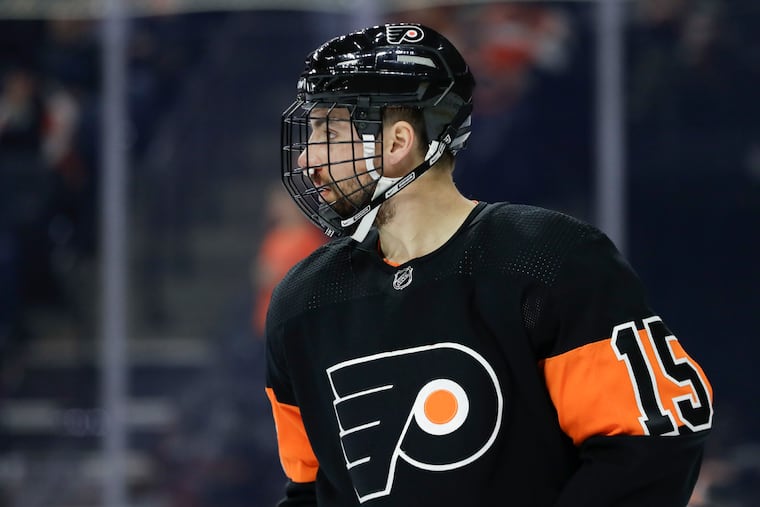Flyers’ Matt Niskanen plans to play like hell. He showed Friday he’s willing to go through it | Mike Sielski
Despite a ghastly injury to his face, Niskanen played his latest solid game Friday in a season full of them.

Throughout his postgame interviews Friday afternoon, Matt Niskanen paused every few seconds, every few sentences, to swallow down a gulp of blood.
A shot had struck his helmet’s visor in the first period of the Flyers’ 6-1 victory over the Red Wings, and upon impact with the puck, the visor had bent downward like a blade, slicing a gash along the outside of his right nostril. It required 15 stitches to close.
His face was a piece of phantasmagoric testimony to the damage his sport can inflict – and its practitioners often withstand.
The stitches were black. Yellow rimmed his eyes, and purple was beginning to pool under the skin below them. The plugs stopping up his nose to staunch the bleeding had gone completely red, and blood had smeared across his chapped lips and spritzed his goatee. There was no pain. He was numb.
“It’s not as bad as it looks,” he said. “I’m assuming it looks pretty bad.”
After Niskanen left the ice, he returned with a protective cage attached to his helmet. Tracking the puck, with the cage’s crossing his eyes, was an adjustment, he said later, but it was no impediment to his collecting two assists – including the primary one on Sean Couturier’s game-breaking goal late in the second period – and playing another solid game in a season full of them.
Out of an offseason in which Flyers general manager Chuck Fletcher – and the franchise’s ownership group – was bound and determined to add veteran players to accelerate the team’s improvement, Niskanen has been as valuable as any. He has joined Ivan Provorov to form the Flyers’ No. 1 defensive pairing.
He sees significant minutes on their power-play and penalty-killing units. And on a roster loaded with young defensemen still learning, still maturing, he has been a calming, reassuring presence. When the puck’s on his stick, no one worries. And even after the puck causes his face to explode, no one worries then, either.
“He’s a great guy to look up to for younger guys, the way he plays, the way he handles himself,” Couturier said. “He just brings that stability. We have a lot of good, young D-men, but sometimes, when you’re young, some nights, it’s tougher, growing into an NHL player. Bringing that experience and leadership stabilizes our whole corps.”
“It’s not only with the way he plays – he plays the right way, with and without the puck – but a tremendous amount of leadership,” Flyers coach Alain Vigneault said. “If you’re a player, young or old, on our team, you see him take a puck off the face, get stitched up, get fixed up, come back, and play the way he did, that’s what we’re looking for from Flyer players, and there’s no doubt that Nisky’s bringing that for us.”
That doubt was the risk in the deal that Fletcher made in mid-June to acquire Niskanen. Fletcher traded Radko Gudas, 29, to the Washington Capitals for Niskanen, 32. The Flyers’ history is littered with trades born of that same template – getting an older, more accomplished player for a younger one – that didn’t work out, and there was reason to believe this one, too, might not work out.
The quality of Niskanen’s play had regressed last season from the previous one, and because he had two years remaining on a seven-year, $40.25 million contract and the Capitals wanted to create some salary-cap space, he effectively priced himself off their roster.
He understood the decision to trade him; in fact, he said, when he signed on to stay in Washington for seven years, it crossed his mind that the very contract that would provide him the measures of wealth and stability that every pro athlete craves might turn out to be the reason he couldn’t be a Capital until the end of his career.
“On the flip side of that,” he said, “I’ve heard horror stories of guys who have taken less or shortened up a deal, and they get traded anyway. There’s a lot of elements to it. But I was aware of it.”
He was also aware, in his mind, of the reason that his play had declined during the 2018-19 season – the first half of the season, anyway. He had played 112 games in 2017-18, including all 24 of the Capitals’ playoff games, at an average of more than 25 minutes of ice time, during their run to their first Stanley Cup. The demands, physical and mental, wore on him.
“I didn’t have a lot of juice some nights,” he said.
He had more than enough on Friday afternoon, even after that errant shot by the Red Wings’ Dylan Larkin had transformed his nose into four square inches of pulp. Two years left on his contract -- 32 doesn’t have to be old anymore in the NHL -- had he given any thought to how long he would keep playing?
“Not really,” he said. “I’ve got two years left on my deal. I’m going to give them hell for two.”
The evidence that Matt Niskanen was willing to go through it was all over his face.